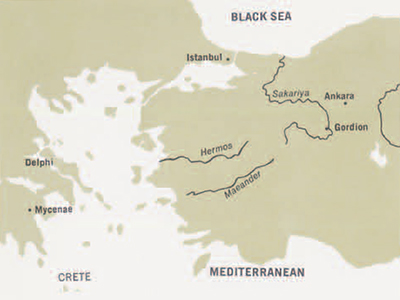 Near the beginning of his history Herodotus tells us that “Midas son of Gordios, king of Phrygia was the first foreigner whom we know to have sent offerings to Delphi. Midas dedicated the royal throne whereon he was accustomed to sit and administer justice, an object well worth looking at.”
Near the beginning of his history Herodotus tells us that “Midas son of Gordios, king of Phrygia was the first foreigner whom we know to have sent offerings to Delphi. Midas dedicated the royal throne whereon he was accustomed to sit and administer justice, an object well worth looking at.”
In remarking that Midas’ throne was well worth looking at” Herodotus’ norm for comparison must have been the Greek furniture which he saw around him every day. Unfortunately almost none of that has come down to us; it was made of wood for the most part, and has perished. We are familiar with the main types and styles of Greek furniture from grave reliefs and from vase paintings. Thus, we have a very good idea of the beds and couches, the chairs and tables, the chests, stools, and boxes used by the Greeks, but in the absence of actual remains we know very little about how they were made and put together, since constructional detail could not easily be shown in carved relief or in painting, and would probably have been considered irrelevant anyway.
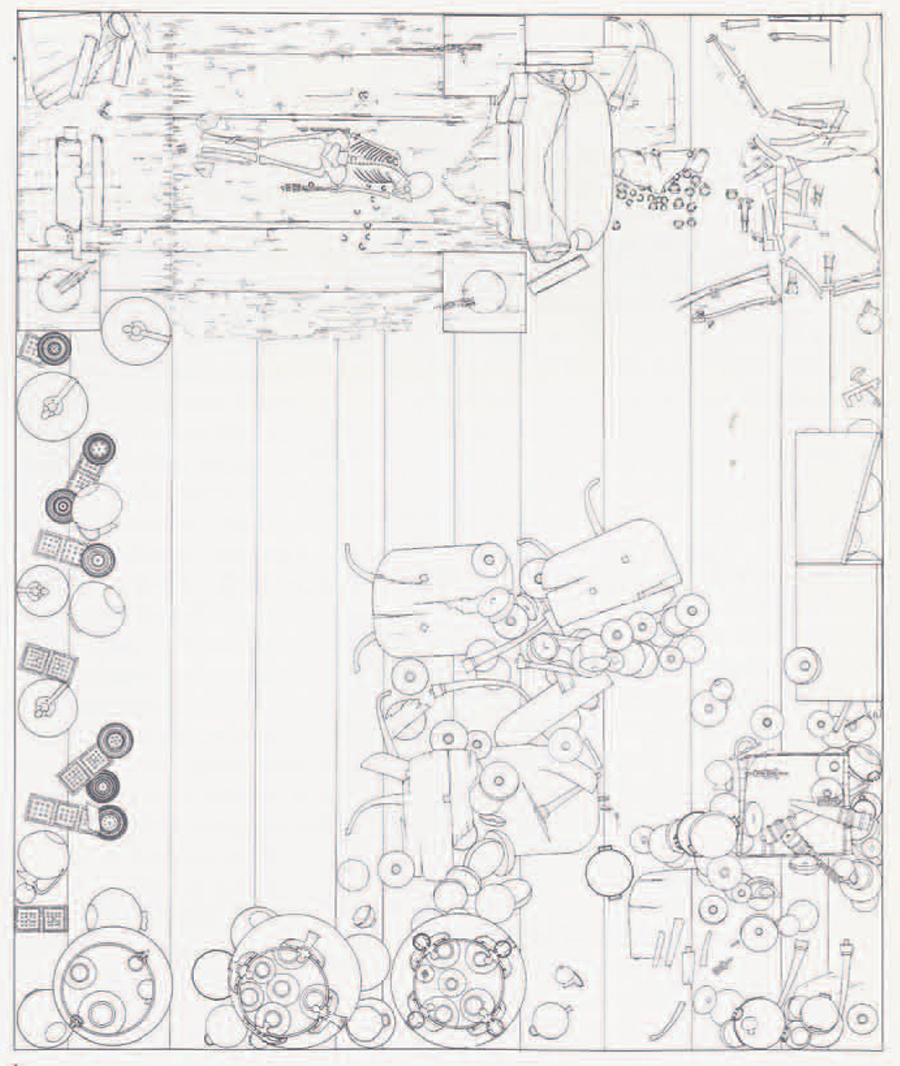
The dry climate of Egypt has preserved to us a large amount of elaborate furniture of wood and of more precious materials, from which the details of construction may be observed. This Egyptian furniture is almost entirely from tombs in which it was safely out of harm’s way, and kept dry. The walls of the tombs themselves, often decorated with carved and painted [ow reliefs depicting scenes from daily life, occasionally illustrate the techniques used in the manufacture of furniture: thus, we have the Eighteenth Dynasty cabinet-maker at work cutting wood while his glue-pot stands at a nearby fire for the glue to be thinned by heating so that it can be used to join the pieces of wood. The techniques of furniture making—the turning of legs on the lathe, their bending to a curved profile by steaming or by soaking, the fastening together of separate pieces by mortise and tenon or by dowels or by glue, the inlaying of surfaces with decorative patterns of wood or ivory or other materials —all must have been widespread throughout the area of the Eastern Mediterranean at an early time, and they perhaps emanated originally from Egypt. No doubt the final product put together by the use of these techniques varied throughout the area hi accordance with the needs and the tastes and the availability of materials in the various regions, so that the furniture of any district bore the peculiar stamp of the local taste and life-style. King Midas’ throne at Delphi must have been worth looking at to Herodotus because by his time it had become rather venerable; because, being foreign, it was somewhat exotic; and because being royal it was probably elaborately made and of rich materials. But at the time of its dedication before 700 B.C. (if its dedicator was that King Midas who died in consequence of the Kimmerian raid of the beginning of the seventh century) the throne could have been of considerable interest from a technical point of view to the emerging Greek cabinet-makers of the time; though God forbid that we should suggest that Greeks needed to learn anything from an inferior barbarian people.
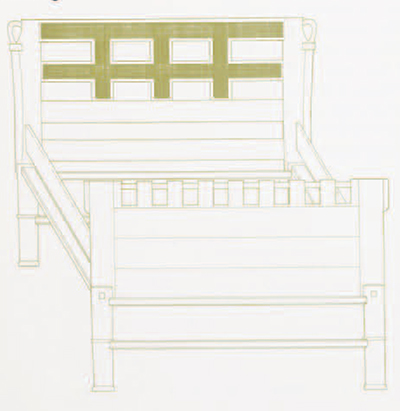
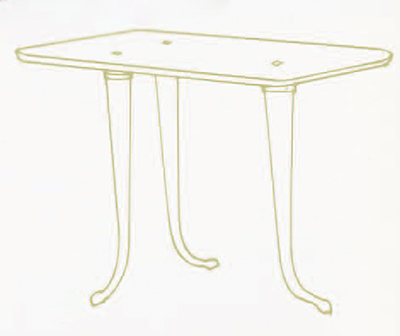
Nevertheless the excavation at Gordion has enabled us to Form a picture of the level attained in the arts and crafts by the Phrygians up to the end of the eighth century. The feast was set, the table spread, and anybody interested or bright enough to be intrigued by Phrygian models might borrow such ideas and techniques as he wished. The tombs at Gordion contained a great deal of Phrygian wooden furniture in more or less good condition. Sealed as they were by the mountainous tumuli of clay piled over them, they were well waterproofed and must have had fairly constant temperature and humidity from the time they were covered until they were opened—conditions ideal for the preservation of wood. The furniture of the child’s tomb (P) suffered great damage at the time of the collapse of the wooden roof under the weight of the stones piled over it, which rendered the arrangement of the things placed in the tomb somewhat chaotic; and the intrusion of water into the king’s tomb (MM) at the time of drilling to locate its position within the tumulus was responsible for some damage. But in both cases the impression was very strong that the tomb chambers were arranged as far as possible to reproduce rooms in the palace which the deceased persons had occupied in their lifetime, and that everything was included that might be required by their spirits for use in the other world.
A glance at the plan of the king’s tomb shows in one corner the great four-poster bed with the skeleton of the king upon it; at its head a table on which once rested the king’s collection of bronze fibulae, On the floor beyond, a scatter of pieces of smaller items of furniture, evidently stools and more tables, which had fallen apart and to a certain extent disintegrated. Leaning against one long wall, two screens which originally had stood in front of it—a back piece of one remained in place at one side, holding a corner of the screen away from the wall-face. Beyond these and filling a third corner, two more collapsed tables. one plain, the other fancy. In the open space around the center of the room six more tables, collapsed and with the bronze bowls which had freighted them scattered over the floor. In the king’s tomb, then, a bed, two screens, and nine tables; also a number of smaller items of furniture which could be neither identified nor restored, but which in some cases had evidently been stacked one on top of another. The tomb would seem to our taste to have been rather overcrowded with furniture and other things; but doubtless it was less spacious than the king’s bedroom in the palace had been.
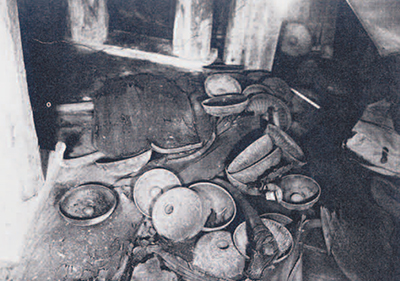
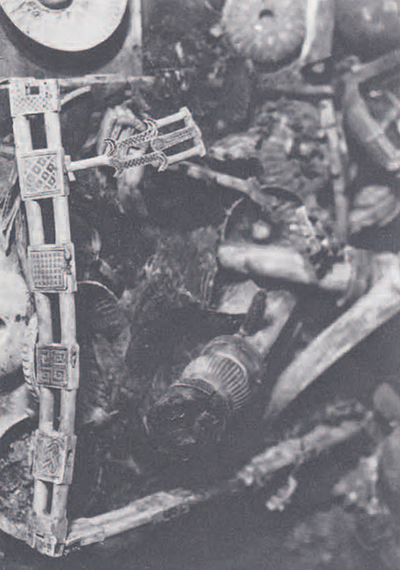
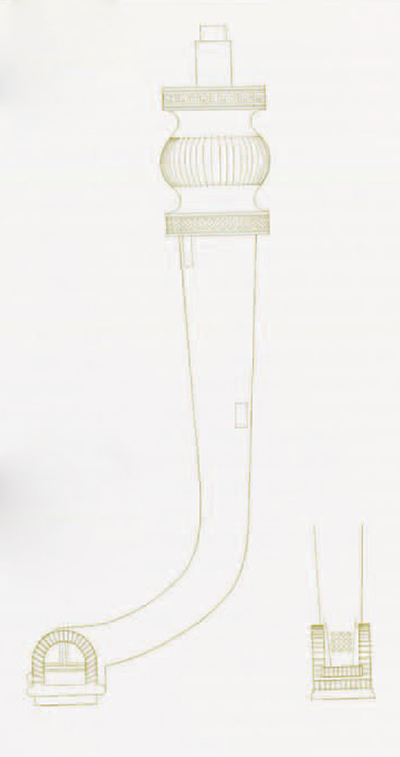
In the child’s tomb the original arrangement of the furniture was less clear, but again there was a large bed in one corner on which the body had been placed, a screen in another corner together with a number of stools, and tables against the wall of one long side. Thus, a certain duplication of the material from the king’s tomb, and at the same time, variation. An examination and comparison of the pieces from the two tombs should give us an idea of what Phrygian furniture was like,
The great bed in the king’s tomb was supported by four nearly cubical wood blocks, one at each corner. Iron bars running across the width at head and foot supported the ends of the lengthwise planks of the bed platform as well as the curlicued head- and footboards at either end. The footboard, which had fallen inward over the lower end of the bed, lay exactly inside the door cut through the wooden wall to gain entrance to the tomb; it blocked access and had to be removed. Beneath its base and running between the corner blocks lay the remains, now mostly rust, of a horizontal iron bar which must have supported it as well as the lower ends of the bed planks. At the head and underneath the thick wads of cloth which had been bedcoverings and had been dragged upward when the headpiece fell outward, lay a heavy line of iron rust, the remains of a similar bar. No doubt the ends of these bars were socketed in cuttings in the faces of the corner blocks, though the socket holes were not preserved. The planks of the bed platform, which had fallen to the floor, were badly decayed and in large part disintegrated. Nevertheless it was possible to discern a wide (about 60 cm.) central plank on which the skeleton lay, and a narrower flanking one at either side. Outside these, two more planks lay between the faces of the corner blocks, which were not prepared in any way to receive or to support their ends. Underneath the outermost planks were found many pieces of the bed rails made from strips of dark and light wood sandwiched together. These had extended most of the way from corner to corner, supported in three places by vertical posts. Tenons at the lower ends of these last indicated that they had been socketed in the surface of the bed platform along its edges. Unfortunately none of the planks was well enough preserved to show any trace of the sockets into which these tenons had been set, so that the full width of the platform could not be assured. The way in which these outer planks had fallen, however, suggested that the inner planks had completed the width at about 1.40 m., or half the depth of each corner block. The outermost planks had probably been stood on edge underneath to support them and to close access to the space beneath the bed. If that were the case the width of these planks, 24 cm., should suggest the height of the platform above floor level.
That the bed had been a four-poster was indicated by the shallow round cutting or bedding in the upper face of each of the corner blocks, and by the fallen fragments of round posts lying near them. These, to be sure, were much less in diameter than the beds made to receive them; but we may assume collars of soft wood, now entirely disappeared, of dimensions to fit these beds, and into which the lower ends of the bedposts were socketed. This system of collaring tenons with separate pieces of wood was common, as we shall see, in the construction of the tables. Of a canopy supported by these corner posts there was no trace, nor of bed curtains hung between them.
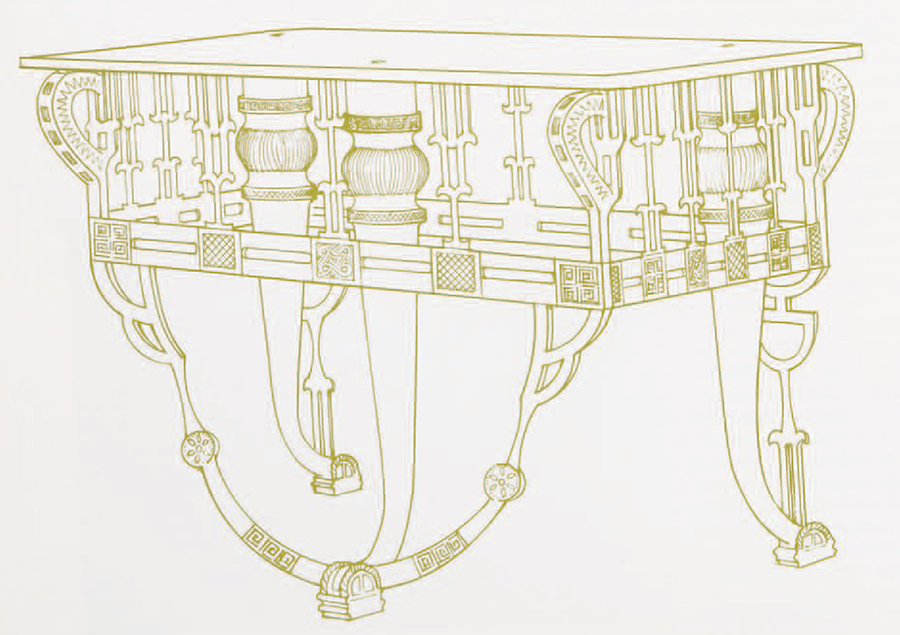
The discomfort of the plain plank surface of the bed may have been mitigated by the many layers of bed clothes spread over it. But the bed itself though uncomfortable was rather grand and fit for a king. It had the virtue, too, of being easy to disassemble and move from one place to another. No doubt it was used by the king while he was alive, then placed in the tomb for further use in the other world.
The child’s bed, while much too big for its occupant, was smaller than the king’s and probably of more normal type. It had been badly smashed by the collapse of the tomb roof, but all the essentials for its understanding and restoration were found. The four legs lay fallen approximately at the four corners of the bed area. Between the legs at the head a frame piece broken into two fragments could be joined to give the width; along one side the frame piece, though it had disintegrated, could be traced through the whole length of the bed because its wood had been of a light color. Mortises at the tops of the legs received tenons at the ends of the frame pieces; at head and foot, lower down and just below the ring-mouldings around the legs, mortises socketed the ends of cross stretchers. There were no cuttings for lengthwise stretchers running between the legs at head and foot. Beneath the bed were many large pottery bowls in which were the remains of food—analysis identified organic matter; these had been placed under the bed from the side where there was no stretcher to impede access. The largest of the bowls was about 36 cm. high; the height of the bed must have been somewhat more, to give clearance. The height of the mortises for the frames above the bottoms of the legs agreed in a general way, though shrinkage and warpage of the wood made accurate measurement impossible. The bed surface must have been 40 to 45 cm. above the level of the floor. It was closed in at the sides by planks on edge, their ends slotted into the head- and footboards; these served as side boards or rails, and also as lengthwise stretchers above the frame to reinforce the stability and rigidity of the whole.
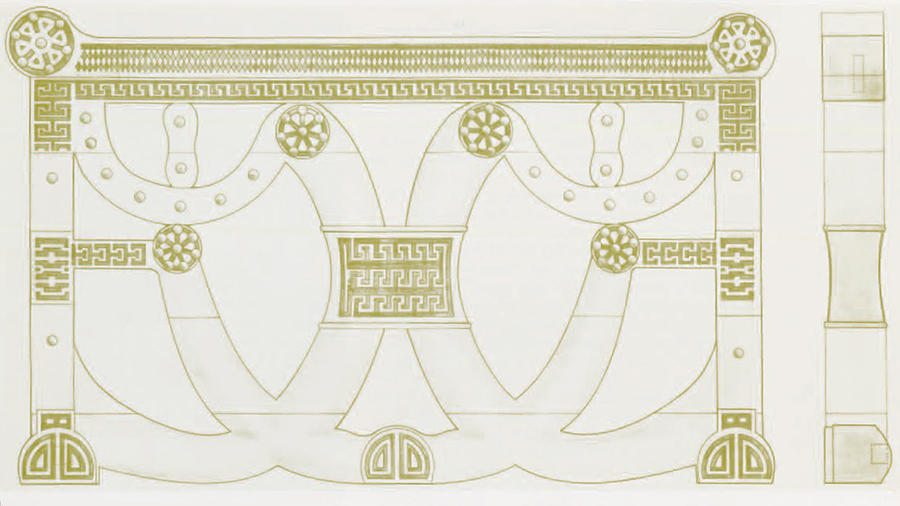
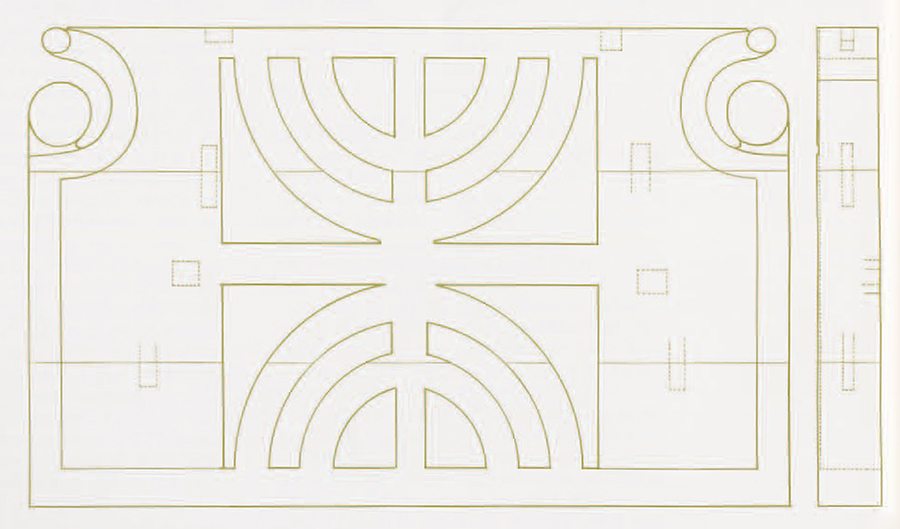
Within the area of the frame lay masses of cloth in which were the bronze belt and fibulae which had been on the body. Screening produced the enamels of some of the teeth of a child four to five years old. But there were no traces of planks like those which formed the bed surface in the king’s tomb. The surface of the bed here must have been of straps of leather or of webbing stretched across the bed from side to side, their ends secured to the lengthwise frame pieces. It is likely that these straps were interwoven with lengthwise pieces attached to the ends of the frame, but how this was done was not clear, since the ends of the frame were at a slightly lower level than the sides, as indicated by the mortises cut through the legs.
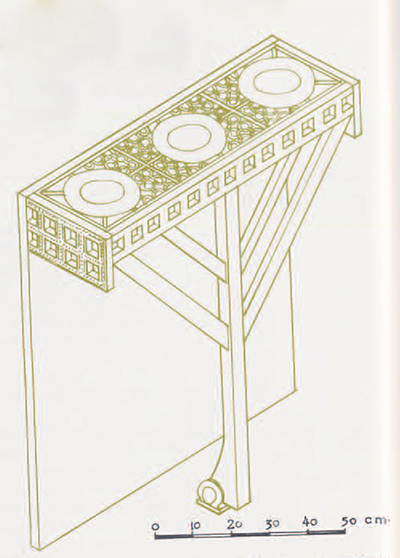
The headboard was evidently slotted into grooves cut in the tops of the legs. Enough fragments of it were preserved to make possible a restoration with some assurance—parts of one corner post, including the handle-like loop at the top, and of the central part decorated by a carved checkerboard pattern. Alternating squares of this may have been inlaid with wood of contrasting color, but if they were, none of the inlays remained in place and perhaps the pattern depended on shadow to be seen rather than on inlay. These horizontal crosspieces were fastened to the corner posts at either side by tenons at the ends secured in place in the mortises by double pins run through from front to back. Of the somewhat lower footboard the crenellated crowning moulding, carved from a single piece of wood, was recovered in fragments. Although not all of the pieces were found the regularity of the design—constant width of crenellations and of intervals between them—made possible a calculation of the total length of the piece, and that calculation accorded very well with the approximate measurement of the width of the bed yielded by the sagged and broken frame piece at the head.
As already mentioned this bed seems much too big for a child five years old. Probably in life he (or she) slept in a crib of some sort, or a much smaller bed. For some reason this was not used for the entombment; rather, a full-size bed from the palace was substituted for it. With its elaborate carved decoration this was a palatial bed, but not a royal one. Thus, it would seem that the bed from the child’s tomb is perhaps more representative, though grander, of the beds in use in well-to-do Phrygian households than the king’s bed is. Certainly it must have been more comfortable to sleep in, and we may guess that bed surfaces made of interwoven strips stretched within the frame were more favored than wooden planking.
Turning from the beds to the tables, we have noted the presence of nine tables in the king’s tomb. More were found in the child’s tomb, even including one with four legs. The general construction of all, however, was the same. The tables of the child’s tomb had been badly smashed when the roof fell in on them, but those from the king’s tomb had merely got tired from old age and from the weight of the bronze bowls piled on top of them, and had sat down—they were found collapsed and lying on the floor. Each of them had three legs and an oblong top rounded at the corners. The tops were slightly dished at the surface, leaving a low raised rim all around the edges; they were usually cut from single pieces of wood and measured roughly 80 by 65 cm. Each showed three square or rectangular holes cut through it in a triangular pattern to socket the tops of the legs. There were three to each table, round in section and tapered downward—evidently lathe-turned. The lower ends curve outward to give wider spread where they rested on the floor and hence better balance. Since the grain of the wood runs the entire length of each leg, it seems inescapable that after turning each leg was artificially bent to a uniform curve by steaming or by soaking the wood in water. At the lower end of each the curved surface underneath has been cut away to leave a flat surface which can rest evenly on the floor. At the top of each leg there is a rather long tenon, square or rectangular in section to fit the holes cut through the table top. Often (though not universally) the tenons are horizontally pierced by round peg-holes at a level nearly half way up. These were used to pin in place collars of soft wood fitted around the tenons and to the tops of the legs. By giving a wider resting-surface for the table top these gave greater stability and rigidity at the joints between top and legs. The tops of the tenons which rose higher than the collars were fitted through the holes in the table top, their ends showing in its surface. The tops as they lay on the floor were 1.5 cm. thick, though the wood may have shrunk to some degree. Finally it may be observed that quite a lot of strong glue must have been used to fasten collars to leg-tops and to tenons, as well as to the under-surfaces of table tops—otherwise the tops would have simply lifted off the tenons if anybody tried to pick up a table to move it. Only a liberal application of glue at all the joints could have held everything together and imparted necessary rigidity to the whole.
The height of these tables could not be accurately measured. When the flattened resting-surfaces at the ends of the legs were held flat to the floor the tenons at the tops were invariably out of the vertical, This was a result of warpage of the wood, which had altered the curve. On the average, however, the tables must have been about 50 cm. high —tables beneath which people of normal stature could hardly have fitted their knees with comfort. Evidently the Phrygians did not sit up to their tables. No chairs were found, and the stools from the child’s tomb, about 35–40 cm. in height, would have again been too high to sit comfortably at a table of 50 cm. Probably people sat on thick cushions or hassocks on the floor. Nevertheless, the tables must have been serviceable: having only three legs (as did most of their Egyptian and Greek counterparts) they sat solidly on the floor and were stable without wobbling. The eight plain tables found in the king’s tomb are all alike, and must give us a picture of what Phrygian tables were like.
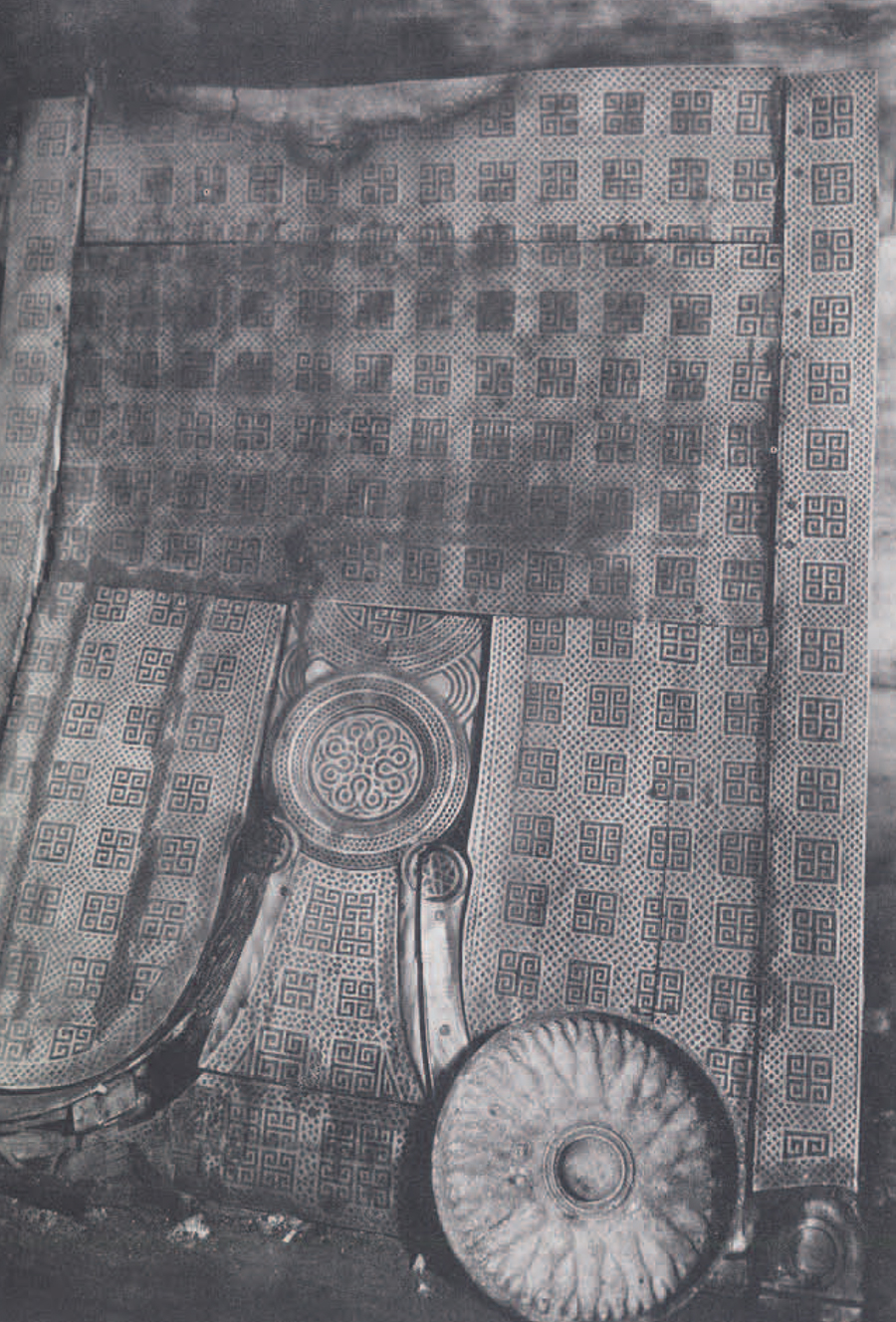
The ninth was bigger and infinitely more elaborately made and decorated. Like all the others it had collapsed; fortunately the pieces had stayed together, and some of them even in place, for the table was made up from more than forty separate pieces and their scattering would have complicated enormously the restoration. The table had a frame joined at the corners by tongues fitted into slots and pinned in place by pegs. Each side of the frame, carved from a single piece of wood, comprised a number of square medallions, inlaid, joined by two horizontal rounded bars. Above each medallion rose a fancily carved and inlaid vertical strut ending in a tenon on its upper surface. Two of these struts had remained in place on the frame; above each medallion was the socket to receive a tenon at the lower end of the rest. There had been eighteen of these struts or supports, all of which were found and could be fitted to their proper places. They were of two different profiles, apparently alternated; at the corners looped handles for carrying the table about were pegged to the end struts. All were elaborately inlaid: on one, decorated with a checkerboard pattern, it was possible to count 193 inlays of dark wood, each a square of about two millimeters an a side. The tenons at the upper ends of these struts must have been socketed in cuttings in the under face of the table tap, which was in such a state of decay that no cutting was preserved. Thus, the upper part of the table consisted of a medallioned frame with handles at the corners; the struts between the corners supported the table top all around near its edge. Without support from beneath the frame would have been suspended below the table top rather than supporting it. Some support for the frame was given by horizontal struts run from the three legs at an appropriate level to its back face—two of these remained in place, socketed into the faces of two legs. But more importantly, vertical props dowelled to the out-turned lower ends of two legs above the feet rose to support two corners of the frame on their under-sides. Since there were only three legs (and four corners to support) the ingenious solution was to dowel a rocker across the end of the third leg, and a prop from each end of the rocker to the two remaining corners of the frame. The legs ended below in scroll feet, inlaid, and above in bulbous vertically ribbed capitals with tenons encased in collars—the top ends of the tenons must have been fitted to holes cut through the table top, as was done in the plain tables. The legs were lathe-turned and tapered; their carved and inlaid capitals had been separately made and joined. Sockets cut in the back faces of the legs attest horizontal struts or stretchers run from leg to leg to give rigidity to the table. All-pervasive and thorough as the system of mortising and dowelling was, it is nevertheless not likely that the whole would have held together rigidly without a liberal application of glue at every joint. The glue, which must have been an organic animal glue, has all vanished. It was the dowels and tenons and mortises which afforded the clues which enabled us to reconstruct the whole and reveal it in its full horror. However much it may revolt us it must be admitted nevertheless that it is from a technical point of view a masterpiece of the cabinet-maker’s craft and certainly worth looking at. Though somewhat higher than the other tables the frame below its top, the corner supports—especially the rocker at one side—would have made it uncomfortable (if not impossible) to sit up at, whether to dine from or to write on.
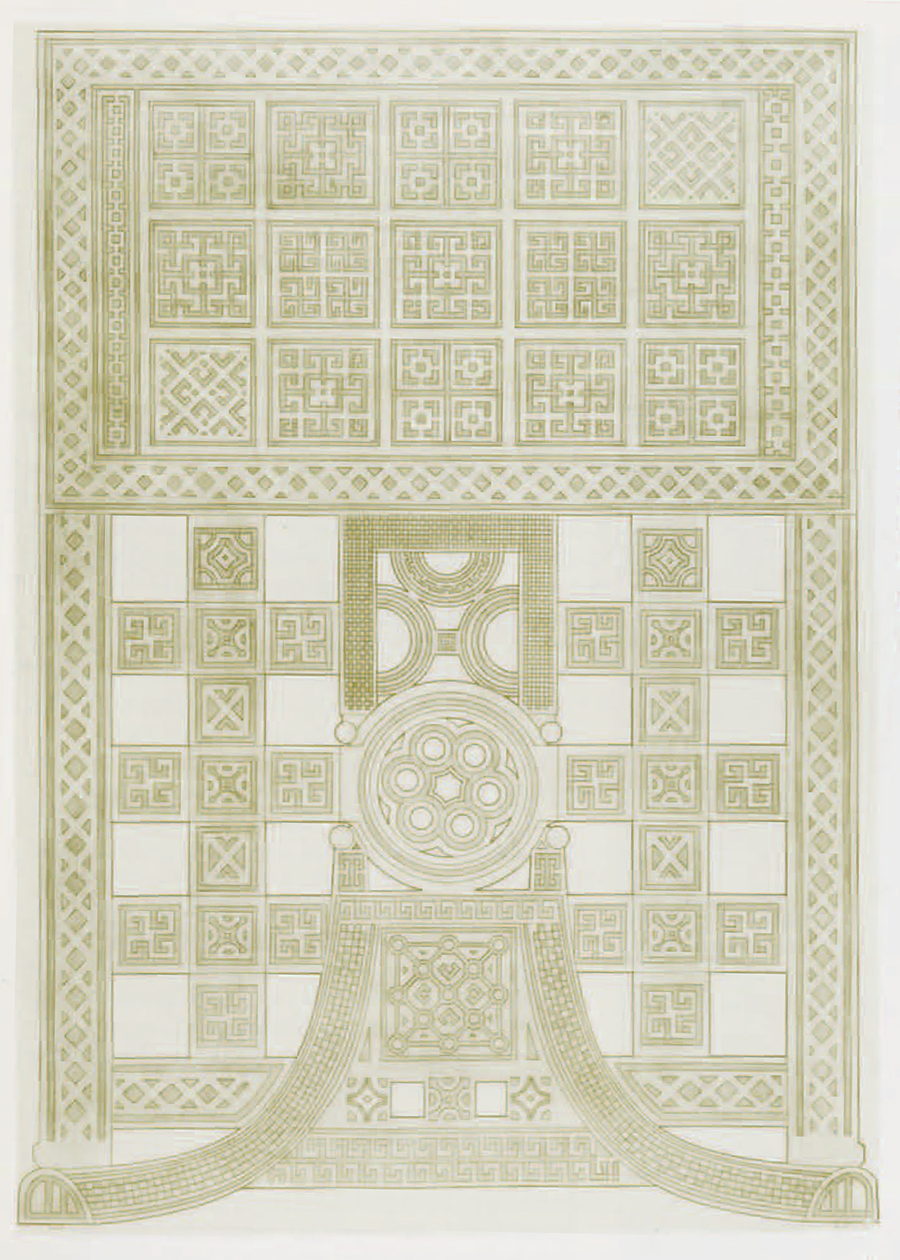
For sitting, the Phrygians had low stools such as were found in the child’s tomb; no doubt also hassocks and cushions laid on the floor. The stools varied in height, from 30 to 40 cm. One of them consisted of front face and back face, with the seat spanning the space between them above. The ends were evidently open. The front face was made from three pieces of wood set horizontally and one on top of the other. These were held together by pairs of dowels across each joint; since the dowels were not pegged to hold them in place they must have been glued. It is likely that the components were first joined together, and that the cutouts which decorate the face were then made—it would have been most difficult to cut the three sections separately and have them fit exactly to each other when they were joined. The front piece of the stool shows two mortises cut into its top face, one close to each end: these must have been for dowelling in place the seat across the top. Two more mortises sunk in the back face of the front piece must have served to bed the ends of horizontal struts or stretchers run across from the front to the back elements of the stool to make it rigid.
A second and much more fancy stool of openwork depended almost entirely on glue to hold it together. It consisted of front and back pieces and four separate slats which duplicate in form the uppermost members of the faces and which must have been seat slats. The front and back members, although the same in form, could be distinguished by the much more extensive inlay decoration of the front face and by the addition of bronze stud-headed tacks for ornament at the front which was lacking at the back. Each was made up from six horizontal pieces of wood. All, except for the topmost piece which was dowelled in place, were fastened together only by glue. We must suppose that gluing was done before the inlaying of the two roundels at the top and the two below them, all of which are crossed by joints. That the components were glued together before the openwork cutouts were made also seems likely, since the central medallion and the struts above and below it would otherwise have been pieces separately made, fitted, and glued in place. Apart from the dowels which fasten the topmost member—the front slat of the seat of the stool—to the next piece below it, the stool front shows mortises only at the back behind the lower corners. These must have bedded the ends of crosspieces joining the front and the back at a low level. We can imagine vertical supports running up from the centers of these to hold an upper crosspiece near the top at seat level, perhaps dowelled to its support but at its ends fastened only by glue to the inner faces of the front and back frames since there are no upper mortises. These upper crosspieces in turn must have supported the ends of the seat slats, which ran parallel to the faces. Again the slats must have been held in place by glue: there are no dowel sockets in their under faces at the ends. Since the combined width of the six seat slats is hardly 20 cm. our seat becomes excessively shallow; so we must space apart the slats to gain enough depth. In the tomb the slats lay in a pile of disintegrated textile which we hope was the remains of a cushion on the seat of the stool. At least a cushion would save a sitter from becoming corrugated on the bottom. This extraordinary piece of furniture gives us some inkling of the strength of the glue which was available to the Phrygian cabinet-makers; but at the same time it makes us begin to fear that furniture like this and like the table from the king’s tomb was typically Phrygian rather than typically royal!
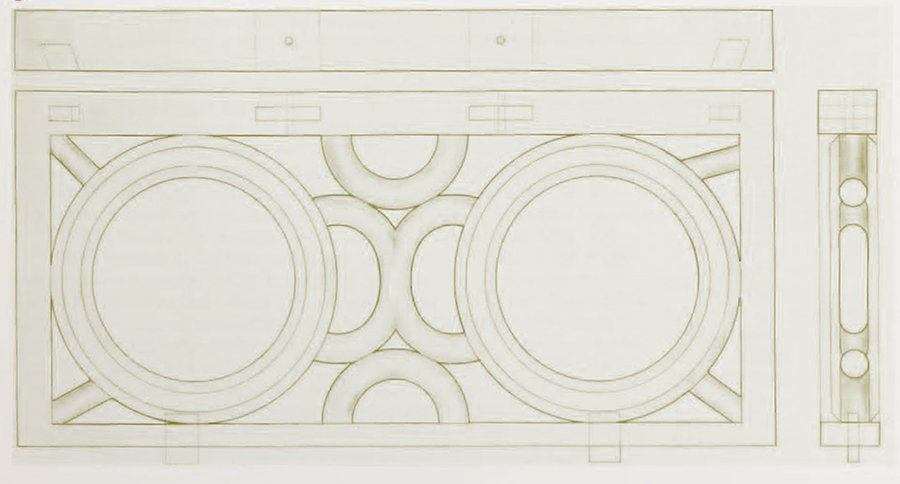
This impression is certainly strengthened by the screens from the two tombs, In the king’s, two screens had been placed standing upright in front of one long wall. Heavy bronze vessels had been suspended from iron nails driven into the wall face above them. These fell, evidently when the nails had rusted enough to give way; and in falling they crashed through the upper parts of the screens below them. Most of the fragments, however, were found as they had fallen, lying on the floor behind the screens. It was possible from these to make restoration (on paper, at least) of the structure at the back of the screens. At the top an oblong frame with openwork side and back pieces was dowelled horizontally to the back of the screen—the pieces were found and could be fitted together. Within the oblong formed by these was dowelled a top piece carved a jour from a single piece of soft wood. The decoration was of linked small rings within three rectangular panels, and near the center of each panel a much larger open ring—these last earned for the screen-top the nickname of “the three-burner stove.” The top piece had been badly smashed by the fall of the bronze vessels, which must have gone through it, and many fragments had disintegrated, but enough were recovered to assure the design.
The back of the frame was supported beneath by a single leg at the center, but to give even support along its entire length two pairs of diagonal struts had been run from the leg to its under surface. The struts were all found, two longer and two shorter ones for each screen, all with tenons and their ends to fit to mortises cut in the side faces of the leg and in the under face of the back piece of the frame. Since no pegs were run through to hold the tenons in place they must have been secured by glue. Solidity and rigidity thus assured, the screens could have been carried about safely from place to place, and set up wherever it was desired, the leg at the back giving support so that the whole could not tip over, forward or backward.
The front part of each screen had been made up from a number of component pieces. These were fastened together by dowels across the joints and pegs run through from front or back to secure them in place—no doubt strengthened also by gluing. The front faces were decorated over-all with inlay and since the patterns of this often run across joints between pieces it follows that all the components must have been assembled before the inlaying could be done. In a few places the inlay crosses the ends of the pegs which hold the dowels; the pegs were in place when the inlaying was done. The woods of which the screens were made have been identified: the light-colored background wood as box, which since medieval times has been a notable export from Constantinople and evidently a product of its Anatolian hinterland; and the dark inlays as yew, called in Turkish porsuk, ogaci or beaverwood, evidently from the name of the river in whose valley it grew, the Porsuk which joins the Sakarya close to Gordion. Pieces from the child’s tomb from which the inlay has fallen out show that the channels to receive inlays had been made by cutting away the wood between shallow holes bored close together in lines with a fine auger—the rounded ends of many of these borings are still visible in the floors of the channels. The beds for inlay were never undercut; the inlays were evidently held in place by glue.
A feature of the decoration of the front faces of the screens that at once reminds us of the table from the king’s tomb is the inclusion of bent-wood legs curving outward to end in scroll feet at the outer corners. The upper ends of these are crowned by a round central medallion or “rose window,” its outer perimeter raised, its center filled by elaborate curvilinear inlaid decoration. The upper area above the medallion shows eight rows of fourteen inlaid swastikas, 112 in all, with seven more rows of ten below, five to each side of the central decoration. More inlays below the medallion complex bring the total of swastikas to nearly two hundred. Close observation shows that they are by no means all the same: in some the swastika proper is of the dark inlaid wood, in others it is left in the light background wood; in some the swastika rolls from right to left, in others from left to right; and in many places the inlays do not form true swastikas at all but rather various patterns which give the same general effect. Between and around these inlays the entire face of the screen is sown with tiny inlaid lozenges and triangles arranged in rows, horizontal and vertical. Quite obviously the construction and decoration of a screen such as these must have been extremely time-consuming; they could not have been made to put in the tomb after the king died, but must have been brought from the palace where they had been in use before his death. They were not, then, special pieces made for funerary use, but pieces made for daily use and so representative of normal (though palatial) Phrygian furniture. The charred remains of at least one similar piece could be recognized lying on the floor of the burned palace where the screen had obviously been in use at the time of the destruction.
A similar, but smaller, screen was found shattered in one corner of the child’s tomb. The upper part of this was broken in fragments but enough remained to reveal the general pattern of the inlays. The lower part, of openwork, had held together; it comprised the central medallion or “rose window,” the outward curved legs ending in scroll feet below it—in this case flat pieces of inlaid wood rather than round lathe-turned legs—and, at each side vertical members joined at intervals by square medallions, leaving open squares between them. Each of these joining squares has a tenon at either side fitted to a mortise in the adjacent vertical strip, and in every case the tenon was secured in place by a peg set in from the back but not through the whole thickness of the wood, so that the peg ends do not show in the face as they do in the faces of the screens from the king’s tomb. This refinement of pegging only from the back may represent an advance in sophistication and technique over the furniture from the king’s tomb. Because of many parallels between things found in the child’s tomb and things found in the destruction layers of the palace in the city we have been inclined to date the burial of the child to a time just before the destruction of the city—to about 700 B.C. The king’s tomb, on the other hand, has seemed somewhat earlier. The refining of his technique by the cabinetmaker could reflect this gap in time between the two tombs; but as the gap can hardly have been more than a quarter century it may well be that the same workshop, or the same artisan, made all the furniture found in both tombs, gradually improving his skills and techniques over the passage of time.
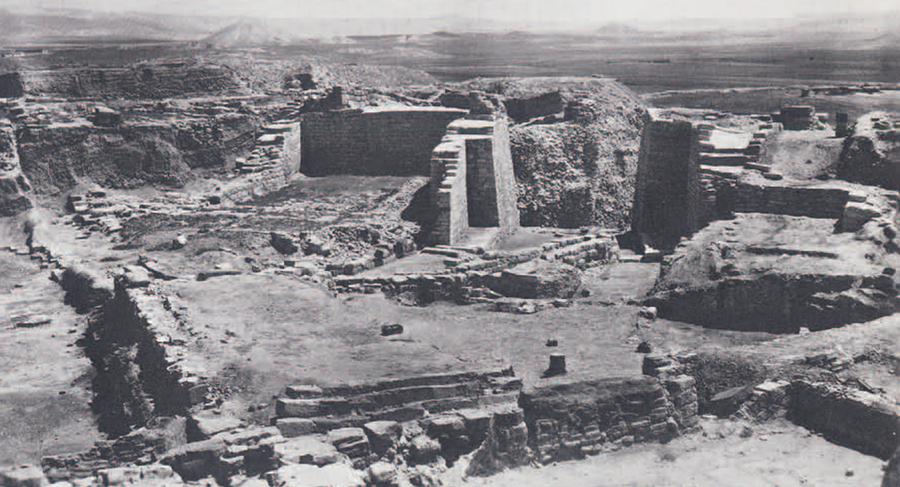
Certainly the excavators’ skills and techniques, as well as their knowledge, increased with the passage of time. The child’s tomb was opened in 1956, and perhaps under the influence of Herodotus’ statement already quoted, the screen within it immediately became a “throne.” The screen itself became the throne-back, supposedly rising behind and above a seat; the horizontal frame at its top, with its dowel-cuttings along one edge, was tentatively mounted across the front face —instead of the back—of the upper edge of the screen, which was too fragmentary to show horizontal dowel-cuttings to correspond to those of the frame. The curved leg was correctly mounted to the frame; but instead of extending downward to make a back leg, it was extended upward and became a canopy holder over the throne! All of this was put right immediately the next year when the nearly intact screens in the king’s tomb were found. Then every piece fell into its proper place, and complete understanding followed of what had been found and misinterpreted the year before. Though the proper restoration of all these screens is assured and their original appearance is now clear, their use is still obscure. That they were not thrones is certain; but in the absence of parallels we are reduced to guesses as to how they were used. Perhaps the best guess is that they were sumptuous backgrounds—throne backs, if you will—before which a magnate could sit in glory on a stool or on a hassock, serving the psychological, if not the physical, functions of a throne.
What, then, of King Midas’ throne at Delphi? Although no actual throne was found at Gordian, Assyrian reliefs show thrones of the ninth and eighth centuries which could well have served as models to be copied or adapted by Phrygian furniture makers. But a Phrygian adaptation would have borne a definitely Phrygian stamp. The various pieces of furniture found in the Gordian tombs, all akin to each other in technique and in style and (alas) in taste, give rein to the imagination in visualizing what the Delphi throne may have been like; at least they give an idea of what the particular Phrygian stamp was like. Remains of burned furniture found in the palace at Gordian widen the scope for imagination: medallions of ivory carved in relief in a Phrygian style had certainly once been inlays in furniture; and pieces of wood, reduced to charcoal by the fire, still showed low reliefs carved in the wood, of processions of animals and men which would have been the surface decoration of furniture. Certainly the throne at Delphi would have been, in Herodotus’ words, worth looking at!
